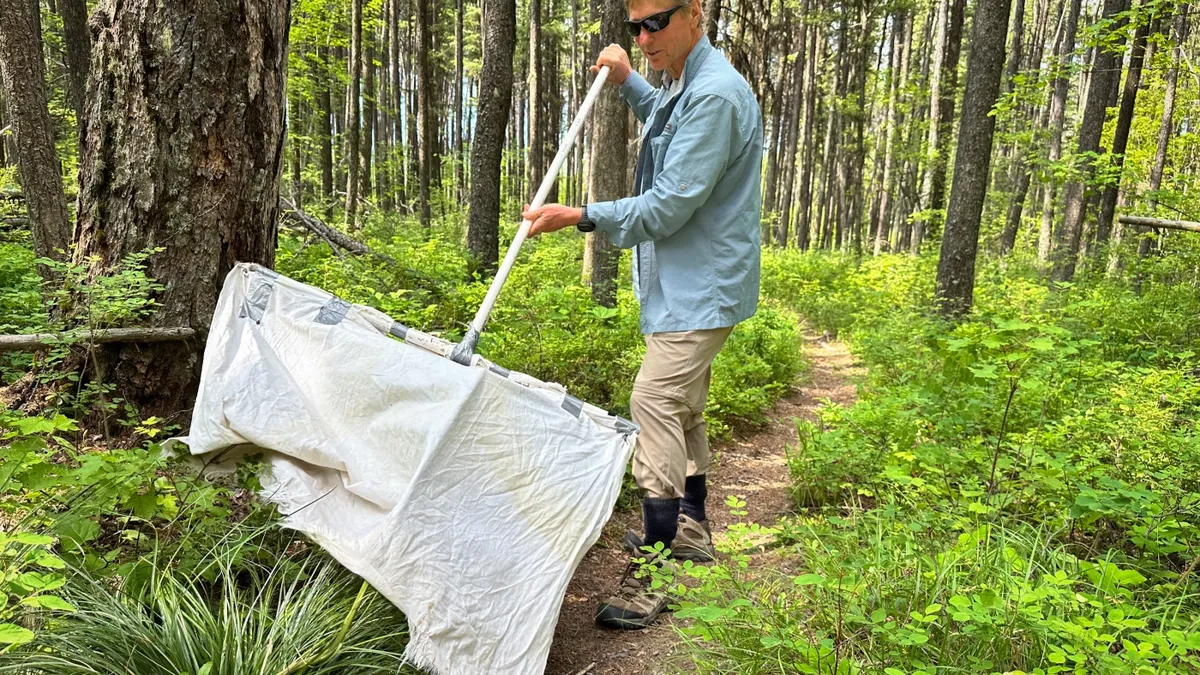
In the picturesque landscape of Condon, Montana, biologist Grant Hokit is conducting crucial research on ticks amidst a serene meadow surrounded by mountains. This small area, featuring a hiking path bordered by long grasses and berry bushes, serves as an important site for his scientific exploration. Armed with a handmade tool crafted from plastic pipes and a large rectangle of white flannel cloth, Hokit’s mission is both lighthearted and serious: to sweep the cloth over the vegetation and capture questing ticks that may latch on.
As Hokit walks the path, he notes the ticks dangling from blades of grass, extending their legs in anticipation of a passing mammal. “We got one,” Hokit exclaims, pointing to a tick he has just captured. “It came off this sedge grass right here.” With careful precision, he picks the tick off the cloth and places it into a vial for further study. Most of the ticks collected during this survey are expected to be identified as Rocky Mountain wood ticks, but Hokit hopes to discover whether new species are infiltrating the state.
One significant concern driving this research is the influence of human-driven climate change. As winters become shorter due to changing climate patterns, ticks are experiencing reduced hibernation periods, resulting in longer active months. This extended activity allows ticks to hitch rides on animals and humans, potentially introducing themselves—and diseases—into new regions. Earlier this year, Hokit made an alarming discovery of deer ticks in northeastern Montana for the first time. Known for their association with Lyme disease, deer ticks pose a potential risk for transmitting various pathogens to humans.
According to Dr. Neil Ku, an infectious disease specialist at Billings Clinic in eastern Montana, many patients do not associate tick bites with the illnesses they develop later. Symptoms such as fever and chills may set in after a tick bite, often leading to confusion about the source of their sickness. “It’s rare that patients connect a tick bite to those symptoms,” says Dr. Ku. This lack of awareness complicates the process of diagnosing tick-borne illnesses, making it essential for healthcare professionals to understand the types of ticks present in the region.
Identifying tick species is vital for informing doctors about potential new diseases that may arise from tick bites. Devon Cozart, a zoonotic illness and vector-borne disease epidemiologist with the Montana Department of Public Health and Human Services, emphasizes the importance of this research. “The more we know about what's in Montana, the better we can inform our physicians,” she states. Cozart is actively involved in collecting and testing ticks from field surveys throughout the state to determine whether they carry any harmful pathogens.
While the prevalence of tick-borne diseases can vary by region, effective surveillance is not uniform across the United States. A 2023 survey of nearly 500 health departments revealed that only about a quarter engage in some form of tick surveillance. Chelsea Gridley-Smith, director of environmental health at the National Association of City and County Health Officials, notes that funding limitations often hinder comprehensive tick surveillance efforts. Many local health departments rely on passive surveillance methods, where concerned patients and veterinarians collect and submit ticks for identification.
Montana receives approximately $60,000 annually from federal grants, but a significant portion of this funding is allocated to mosquito surveillance, which is typically more intensive and costly. As a result, limited resources restrict Hokit’s ability to conduct thorough tick surveys across the expansive state. Despite finding new populations of deer ticks in two counties, Hokit lacks sufficient data to determine if these ticks are establishing a breeding population locally.
To enhance understanding of tick populations, Hokit is utilizing data on climate and vegetation to predict where deer ticks might flourish in Montana. He is particularly focused on areas of western Montana, including the Flathead Valley, as potential hotspots for future tick activity. This proactive approach aims to inform the public about the potential arrival of deer ticks and the diseases they can carry, ultimately improving public health outcomes in the region.